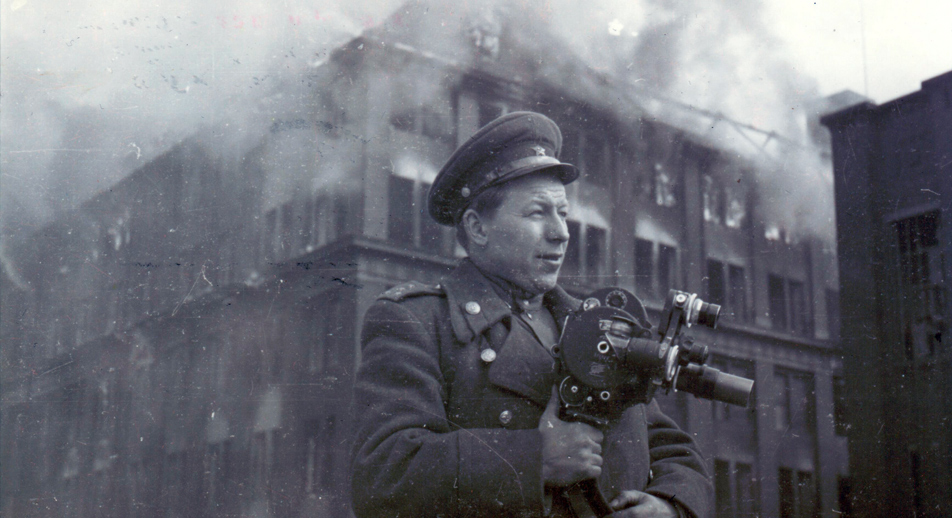
Boris Sokolov. Source: Personal archive
In 1941, I was 21. Because of the war, the students from the institute (the Gerasimov Institute of Cinematography – RBTH) graduated early, while I was already doing my internship. That's when they started to form frontline film crews. I began to beg, but was told "no." Of course, I understood that experienced cameramen were sent first. However, filming under the conditions of war was not taught anywhere. It was in the German army that they had training courses for military cameramen, but we did not.
I was first sent to the defenses near Moscow, and then I went back to the studio, and it was evacuated to Alma-Ata [the capital of the Kazakh Soviet republic at that time – RBTH]. I was with my friend, cameraman Misha Poselsky. A couple of months later, he managed to get to the front in a film group, while I remained in the evacuation zone.
I kept begging to be sent to the front. The whole country lived the war. "Everything for the front, everything for victory," the slogan went. And I wanted to be a participant in these events. Unfortunately, this desire was not fulfilled until 1944. It was the last recruitment campaign. The front stood near Warsaw. It remained there for three months, and we filmed the everyday life of the army.
There was fear, but we forgot about it as we were working, although our losses were great. Throughout the war, 258 people worked at the front and used more than 3.5 million meters of 35 mm film. One in five died. Some were wounded or shell-shocked. I've been asked if we were guarded when filming. There were no guards; we were left to ourselves.
There were no zooms then, you needed to change lenses for different scales. The camera itself weighed about 3.5 kg [8 lbs]. Well, then, we also had rolls of film. Thirty meters of film, while the winding mechanism could roll only 15 meters [50 feet] at once – this is only half a minute of screen time. You had to replace it in a bag or in a dark room in order not to expose the film. If it was replaced in the bag, it was all done by groping around. Replacing the roll took about 5-10 minutes or even more.
Video: WWII through the lens of a war cameraman. Source: RBTH
We filmed either on an American Aimo camera or on its Soviet version – the KS. And we could film everything, but it depended on censorship whether it made it to the screen or not. I wasn’t yet at the front when we were suffering defeats [in 1941 and 1942 – RBTH], but, according to my comrades, the retreat was barely filmed. I know of cases where cameramen tried to capture the retreat, but soldiers and refugees asked them not to, often with threats.
Of course, my most vivid memory is the signing of the act of surrender of Germany. Poselsky and I were given the task of filming the German delegation. I was particularly struck by the behavior of Field Marshal Keitel [chief of the Supreme Command of the Wehrmacht – RBTH]. It was as if he were not the defeated, but the winner. When he exited the aircraft, he greeted those who met him with his marshal's rod, though it was only guards who met him at the airport. None of the officials came. He also welcomed with his rod those present in the room for the signing, but none answered. When Keitel signed the act, I thought that was it, that the war had ended at that point. Relief was the general impression. Unfortunately, I was wrong. But at the time this was the feeling that I had.
During the Battle of Berlin, Soviet flags, more than 10 of which had been distributed, gradually appeared on different floors of the Reichstag and were stuck in the windows. On the night of April 30 to May 1, it appeared on the dome. But we could not film at night – there wasn’t enough light, even despite the fires. Therefore, some moments were staged, shot in the daytime. Many believe such filming is deception, but it is just the restoration of the facts.
I saw some of my footage in the film The Great Patriotic War, which was called The Unknown War when shown abroad. Also in Andrei Tarkovsky's film Ivan's Childhood – a prison in the city of Poznan, Poland.

Boris Sokolov, 2015. Source: Pavel Inzhelevsky / RBTH
We filmed a guillotine in one of the rooms of this prison. And we didn’t even know that Tarkovsky had used it. I was told only later.
The wartime films that have been now transferred from black and white to color impress me less. At that time, I imagined the material visually in black and white, we thought in black and white. I have no desire to switch to color.
All rights reserved by Rossiyskaya Gazeta.
Subscribe
to our newsletter!
Get the week's best stories straight to your inbox